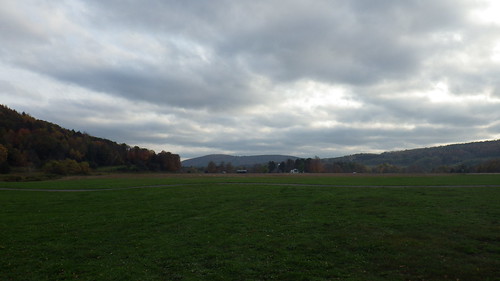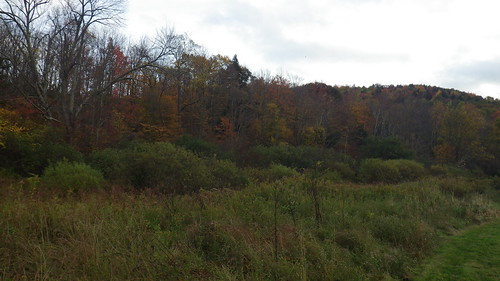It's been a bit sparse around here, not necessarily for lack of things to blog about, but for lack of time in which to do so. But, I've always heard that you should never apologize for not updating your blog, so that's something I'm not going to do. Instead, since I do have a bit of time right now, I'm going to finish a post I've been meaning to finish for some time, with updates about a conference I recently attended, and one that's coming up.
First, I've recently returned (actually, the conference was the first weekend in October, so not all that recently) from the Conference on Medieval Archaeology at SUNY Cortland, organized by Scott Stull. As much as I love San Diego, it was very nice to be back in the northeast for at least one weekend of true autumnal weather, and the conference itself was quite interesting, as well. I was presenting a fairly general introduction to our work on the Islamic periods in Faynan, since the audience consisted of people working on medieval archaeology in several regions, primarily western Europe. Some observations: 1) I was pleased to see that Scott went with an amusing acronym. I'm not sure if CoMA is better than MIRE, but I'm happy to have been at both. 2) Beyond my own anxiety about the term "medieval," this also really brought home some conversations I've had with other Islamic archaeologists — Bethany Walker especially comes to mind — about communicating periodization across space, where dynastic and archaeological periods don't translate. It's not that it's difficult to default to calendar dates, but that a lot of the assumptions that come with dynastic and archaeological terms have to be made explicit. And then there are the dynastic terms that are used in multiple regions, but not in the same way; at one point, I found myself saying something along the lines of, ". . . Late Byzantine, which would be Early Byzantine in central Anatolia." Certainly that's not confusing. 3) On those same lines, it was interesting and, I think, useful to be odd person out at a fairly small, focused conference. (Interestingly, I spoke with a few other presenters who also felt that they were "outsiders.") I've been at conferences where the Levant wasn't very well-represented, but even at the most recent SAAs we were in an "Archaeology of Jordan" session. I've had to gear talks to people working on earlier periods in the Levant, but it was a different experience speaking to a room almost entirely full of archaeologists working on the same period, but in Europe.
After the conference, I managed to take a little drive over to Brewery Ommegang in Cooperstown, NY. I wasn't entirely sure what to expect from their tasting room (apart from the beer, which I knew would be excellent), since they're part of the rapidly expanding Duvel Moortgat family, but I was pleasantly surprised. Their cafe was, from a San Diego perspective, fairly small and cozy, and the location is really rather out of the way. As evidence, here are two photos I took in their overflow parking lot.
That's definitely a nicer view than most of the parking lots I've been in can boast, and I always enjoy being reminded of how much I love the northeast in fall. It's a comforting thought, especially now that I'm back in San Diego, where the forecast for tomorrow is 87 degrees and sunny. In November.
Of course, I'll be heading to cooler climes again soon enough. This year's ASOR Annual Meeting in Baltimore is just over a week away, and I'm excited to go this year. Our field season tends to conflict with ASOR, so it's not every year I can actually attend, and although I've been several times before, this is actually the first year I'll be giving a paper. This is also the first time I'll be speaking at length about our 2012 excavations at Khirbat Nuqayb al-Asaymir, and the "Archaeology of Islamic Society" session that I'm in this year looks quite good, so I think it's going to be an interesting conference. And, since I'm speaking about it anyway, it seems appropriate to end with my abstract for this year.
Life in a Mining Village: Insights from Domestic and Public Buildings at Middle Islamic Khirbat Nuqayb al-Asaymir, Faynan, Jordan
Ian W. N. Jones, Mohammad Najjar, and Thomas E. Levy
At some point in the late 12th century AD, due to changing economic conditions in Bilad al-Sham, the Faynan district of southern Jordan became an attractive source of copper, after a hiatus in production of more than half a millennium. In addition to reoccupying existing sites, a small copper smelting village, now known as Khirbat Nuqayb al-Asaymir (KNA), was founded during this period. While interesting from the perspective of production, exchange, and consumption, this village also provides a unique opportunity to investigate the mining settlement as a unique social formation, and to address questions not answered in historical sources of the Middle Islamic period.In order to take advantage of this opportunity, the UC San Diego Edom Lowlands Regional Archaeology Project’s (ELRAP) 2012 excavations at KNA focused primarily on non-metallurgical contexts. A large, “elite” building was partially excavated and revealed three distinct building phases, including both metallurgical and pre-metallurgical, elite strata of the Middle Islamic period. Additionally, two probes were dug in domestic buildings, and a third probe conducted in a small, one-room building which may have been a guardhouse.This paper presents some preliminary conclusions from these excavations, focusing on (1) the differences between the excavated domestic buildings, (2) identifying “elites” archaeologically at KNA, (3) the transformation of the elite building into a metallurgical workshop, and, finally, (4) the implications of the ceramic assemblage both for life and food preferences at the site and for Middle Islamic ceramic typologies in southernmost Bilad al-Sham more generally.

